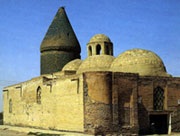

Central Asia - Turkmenistan |
| ABOUT TURKMENISTAN | ||
|
||
| What to See | ||
|
||
| How to Get There | ||
| Turkmenistan's capital Ashgabat has regularly
scheduled air links with London, Frankfurt, Moscow, Abu Dhabi New
Delhi Karachi, Tehran, Istanbul and other regional foreign cities
Tourists can also enter the country at the Caspian Sea port of Turkmenbashi
Within Turkmenistan there is air service to provincial cities from
the capital All Silk Road sites are served by air rail or road transport.
|
||
| Where to Stay | ||
There is a network of modern hotels around the country with
nine five star establishments for 648 people, three four star hotels
for 53 people and two two star hotels which can accommo date 91
people There are also more modest facilities Ashgabat's better hotels
have conference facilities. |
||
| Other Important Sites | ||
|
||
| Location | ||
| The Republic of TURKMENISTAN occupying over 717, 300
sq. km, is the Turkmenistan lies in the very center of the Central
Asia. This Location predetermined historically its great geopolitical
importence on the major transasian lines of communication between
the East and the West. Turkmenistan border with Kazakhstan, Uzbekistan,
Iran and Afganistan. |
||
| Relief | ||
Turkmenistan covering vast territory is notable for
the extremely diverse relief: from high snowy mountains to steppes,
semidesert and desert. The lowest place in the World, situated in
the West. |
||
| Klimate | ||
Climate of Turkmenistan is sharp continental. |
||
| Population | ||
Turkmenistan is a multinational state. There are
over 5 million inhabitans in Turkmenistan today. Turkmen make 48%,
Russia 30%, other nationalities (over 100) 22%. |
||
| Language | ||
| Turkmen and Russia, the official landuage of the
country, belongs to the TURK group. Russan remains the language
of the interethnic communication. |
||
| Religion | ||
Multinationality of the state determines a divirsity
of religions. The main ones are Islam & Christianity. |
||
| Capital | ||
The city of ASHGABAD with the population of 600 thousands is the capital of Turkmenistan. Ashgabad was founded as a Russia garrison town three days after the killing of 20000 Turkmens at GeokTeppe in 1881, and was hit by earthqake's in 1893, 1895 and 1929. In 1948 the earthquake completely destroed the city and killed 110, 000. |
Copyright © 2004-2012 PAMIR TRAVEL
Made by: MabigaTeam


